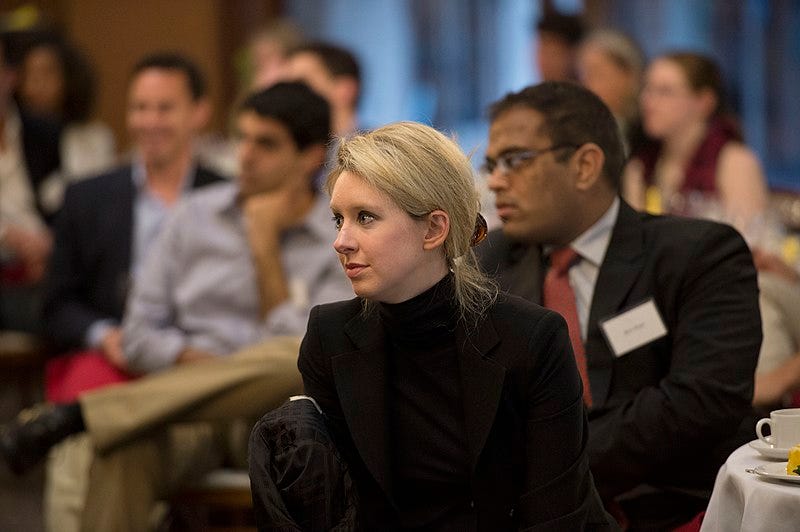The Rise and Fall of Elizabeth Holmes: A Silicon Valley Saga
Written on
Chapter 1: The Illusion of Success
At just 19, Elizabeth Holmes launched Theranos, a company that promised to revolutionize blood testing. By age 30, she was being lauded by some of Silicon Valley's most influential figures, who eagerly backed her ambitious project. However, within a mere four years, the empire she built began to crumble. Holmes was eventually convicted of four out of eleven fraud and conspiracy charges in a San Jose federal court, facing a potential prison sentence of up to 20 years. In this article, we will explore the details of her trial and the groundbreaking enterprise she established.

Holmes founded Theranos in 2003 — [Photo: Tali Mackay at English Wikipedia, CC BY-SA 4.0, via Wikimedia Commons]
In the words of prosecutor Robert Leach, “This case revolves around deceit, falsehoods, and manipulation to secure financial backing,” as reported by CNN Business. The proceedings captured substantial media attention, especially considering Holmes had graced numerous magazine covers and appeared on major television networks during Theranos' peak.
She was accused of misleading investors out of $724 million, with high-profile backers like former U.S. Secretary of State Henry Kissinger and media mogul Rupert Murdoch, which helped bolster the company's credibility. Holmes was also recognized for her remarkable charisma and persuasive abilities. While soliciting funds for her innovative blood testing technology, she was fully aware that it was ineffective, as detailed in John Carreyrou’s book, “Bad Blood.”
At its pinnacle, Theranos was valued at $9 billion, and with Holmes holding 50% of the company, her net worth reached an estimated $4.5 billion. Forbes even labeled her the youngest self-made female billionaire. She often drew comparisons to Steve Jobs, a likeness she actively cultivated, frequently appearing in his signature black turtleneck.
The prosecution's claim is that Holmes not only deceived investors, partners, and medical professionals but also misled the media and the public while jeopardizing patients' health. She claimed that Theranos could swiftly assess a patient’s cholesterol levels using just a drop of blood from a finger prick and promised to conduct numerous tests from a single sample. The company’s nanotainers—small vials for collecting samples—became a symbol of her purported technological breakthrough. In interviews, she revealed that her fear of needles inspired the creation of Theranos.

Meanwhile, independent tests revealed that Theranos’ technology was accurate only 12% of the time. Patients who placed their trust in the ambitious entrepreneur could receive misleading test results, leading to potentially harmful health decisions.
Section 1.1: The Defense Argument
Holmes, now 37 and a new mother, maintains her innocence. Her attorney, Lance Wade, stated, “Elizabeth Holmes didn’t arrive at work each day with the intention to deceive or commit theft. The government wants you to believe that her entire existence is based on fraud, which is simply untrue.”
Wade contended that Holmes dedicated 15 years to a project that ultimately failed. “Failure isn’t a crime,” he emphasized, attempting to persuade the jury to view Theranos’ collapse as a typical business misfortune rather than a criminal act that could warrant a 20-year sentence. The defense also characterized Holmes as a young leader who “naively underestimated” the challenges of the business world.
Further court documents reveal that Holmes’ legal team sought to shift some blame to Ramesh “Sunny” Balwani, her business partner and former romantic interest, who is facing similar charges. Although her lawyer did not state it outright, he implied that Balwani’s influence affected Holmes’ business choices. Dr. Mindy Mechanic, a specialist in domestic violence, was among the defense witnesses called.
Conversely, the prosecution presented a whopping 180 witnesses, including Rupert Murdoch, who reportedly invested over $100 million in Theranos. Other notable figures included attorney David Boies, former Secretary of State Henry Kissinger, and ex-Secretary of Defense James Mattis. Patients who experienced negative consequences from inaccurate test results also provided testimony.
The trial was replete with evidence, featuring correspondence between Holmes and influential figures, emails from Murdoch, and text messages with Balwani. Ultimately, Holmes was found guilty on four counts of fraud and conspiracy, facing a maximum sentence of 20 years in prison.
Chapter 2: A Cautionary Tale
The first video, "Silicon Valley Scammers - Theranos," provides an in-depth look at the rise and fall of Elizabeth Holmes and Theranos, highlighting the deception that captivated Silicon Valley.
The second video, "The 'Fake' Steve Jobs | How Elizabeth Holmes Became The Biggest Fraud In Silicon Valley," explores how Holmes' ambition led her to become a notorious figure in the tech industry.
Can you really die laughing? — History shows that you can.
Death after winning a bowling game? Or while watching your favorite comedy? It's very likely, though it’s hard to say...
Thank you for reading this article! Your appreciation means a lot, so if you enjoyed it, please leave some claps and consider following me for more content. Thank you!